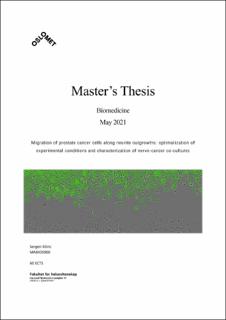| dc.description.abstract | As approximately 5000 males are diagnosed with prostate cancer every year in Norway, prostate cancer persists as a medical issue today. It is shown that tumor innervation is important for development and progression of the tumor, as sympathetic impulses induces adrenergic activity in the tumor microenvironment. Increased adrenergic activity plays an important part of supplying the tumor with blood and nutrients by inducing angiogenesis and neurogenesis. The 2-adrenergic receptor (ADRB2) is the most prevalent adrenergic receptor in luminal cells of the prostate, contributing to progression and development of prostate cancer. ADRB2 has been shown to induce neuroendocrine differentiation (NED), trans differentiating prostate cancer cell to neuroendocrine-like (NE-like) cells, which is known to promote tumor progression and recurrence by autocrine stimulation and apoptosis resistance by attaining NE-like characteristics. Our research group have shown that patients using -blockers, ADRB antagonists, have reduced prostate cancer related mortality.
The overall aim of this study is to demonstrate the migration of the prostate cancer cells (PC-3-Luc2-GFP and C4-2B) towards neural PC-12 ADH cells pre-stimulated to induce neurite outgrowth and Schwann cells (RSC96), to characterize their migration rate. By stimulating the cell lines with the rho-associated kinase-inhibitor (ROCK-inhibitor) and the ADRB2 agonist isoproterenol (ISO), we wanted to determine the optimal concentration and time of each stimulation to induce the longest and highest number of neurite.
By stimulating the cells with ROCK-inhibitor and ISO, we demonstrated that 50 M ROCK-inhibitor induced the highest total neurite length per cell. This was mainly due to the increased number of neurites per cell although the average neurite length was also substantially increased in PC-3-Luc2-GFP cells. A migration assay was performed, demonstrating that the PC-3-Luc2-GFP cell line had the highest migration rate, in which the stimulation with ROCK-inhibitor did not decrease the migration in our study. We demonstrated that stimulation with ROCK-inhibitor, decreased the migration of PC-12 ADH cells and RSC96 cells. In contrast to C4-2B cells, stimulation with 50 M ROCK were shown to decrease the proliferation in PC12 ADH and RSC96 cells as well as in PC-3-Luc2-GFP cells. ISO had no effect on cell growth in either cell lines. Taken together, the results of this study indicates that use of ROCK inhibitor can reduce the growth and progression of prostate by suppressing prostate cancer proliferation and cell migration toward nerves. | en_US |
